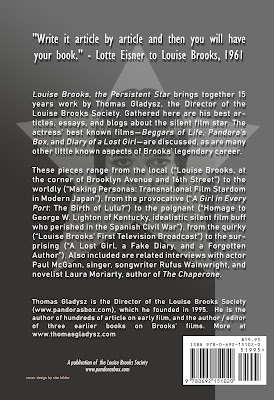There's double trouble coming up in September at South West Silents in the UK !
On September 14th, the sensational Louise Brooks film, Diary of a Lost Girl, will be shown at Cube Microplex in central Bristol, England. More information about this event can be found HERE.
South West Silents presents: Diary of a Lost Girl (1929)
with introduction and live musical accompaniment
And on September 16th, the equally provocative Louise Brooks film, Pandora's Box, will be shown at Curzon in Clevedon, North Somerset, England. (The Curzon cinema has been at the centre of cultural life in Clevedon since 1912.) More information about this event can be found HERE.
G.W. Pabst's 1929 silent masterpiece Pandora's Box stars Louise Brooks in the role that secured her place as one of the immortal goddesses of the silver screen.
This controversial, and in its day heavily censored, film is regularly ranked in the Top 100 films of all time (including Cahiers du Cinema and Sight & Sound). Brooks is unforgettable as Lulu (Louise Brooks), a sexy, amoral dancer who creates a trail of devastation as she blazes through Weimar-era Berlin, breaking hearts and destroying lives. From Germany, she flies to France, and finally to London, where tragedy strikes. This stunning photographed film is loosely based on the controversial Lulu plays by Frank Wedekind, and also features one of the cinemas earliest lesbian characters.
Showing as part of this year's Heritage Open Weekend which celebrates Heritage sites all over the UK.
On September 14th, the sensational Louise Brooks film, Diary of a Lost Girl, will be shown at Cube Microplex in central Bristol, England. More information about this event can be found HERE.
South West Silents presents: Diary of a Lost Girl (1929)
with introduction and live musical accompaniment
Dir: G.W. Pabst, 1929, Germany, 106 mins, Cert: PG
-
Fri 14 September // 20:00
Fri 14 September // 20:00
Tickets: £8 (full) / £7 (concession)
A masterpiece of the German silent era, Diary of a Lost Girl was the second and final collaboration of actress Louise Brooks and director G.W. Pabst a mere months after their first collaboration in the now-legendary Pandora’s Box (1929).
Brooks plays Thymian Henning, a beautiful young woman raped by an unscrupulous character employed at her father’s pharmacy (played with gusto by Fritz Rasp, the degenerate villain of such Fritz Lang classics as Metropolis, Spione, and Frau im Mond). After Thymian gives birth to his child and rejects her family’s expectations of marriage, the baby is torn from her care, and Thymian enters a purgatorial reform school that seems less an institute of learning than a conduit for fulfilling the headmistress’s sadistic sexual fantasies.
The screening will have a specially recorded audio intro by author and critic Pamela Hutchinson with live music on piano by Jonny Best (Yorkshire Silent Film Festival).
“Brooks exudes a hypnotic resilience, retaining a transcendent moral decency in a corrupt world.” Philip French, The Guardian
Brooks plays Thymian Henning, a beautiful young woman raped by an unscrupulous character employed at her father’s pharmacy (played with gusto by Fritz Rasp, the degenerate villain of such Fritz Lang classics as Metropolis, Spione, and Frau im Mond). After Thymian gives birth to his child and rejects her family’s expectations of marriage, the baby is torn from her care, and Thymian enters a purgatorial reform school that seems less an institute of learning than a conduit for fulfilling the headmistress’s sadistic sexual fantasies.
The screening will have a specially recorded audio intro by author and critic Pamela Hutchinson with live music on piano by Jonny Best (Yorkshire Silent Film Festival).
“Brooks exudes a hypnotic resilience, retaining a transcendent moral decency in a corrupt world.” Philip French, The Guardian
Learn more about Diary of a Lost Girlon the Louise Brooks Society website.
And on September 16th, the equally provocative Louise Brooks film, Pandora's Box, will be shown at Curzon in Clevedon, North Somerset, England. (The Curzon cinema has been at the centre of cultural life in Clevedon since 1912.) More information about this event can be found HERE.
G.W. Pabst's 1929 silent masterpiece Pandora's Box stars Louise Brooks in the role that secured her place as one of the immortal goddesses of the silver screen.
This controversial, and in its day heavily censored, film is regularly ranked in the Top 100 films of all time (including Cahiers du Cinema and Sight & Sound). Brooks is unforgettable as Lulu (Louise Brooks), a sexy, amoral dancer who creates a trail of devastation as she blazes through Weimar-era Berlin, breaking hearts and destroying lives. From Germany, she flies to France, and finally to London, where tragedy strikes. This stunning photographed film is loosely based on the controversial Lulu plays by Frank Wedekind, and also features one of the cinemas earliest lesbian characters.
Showing as part of this year's Heritage Open Weekend which celebrates Heritage sites all over the UK.
Learn more about Pandora's Box on the Louise Brooks Society website.



































